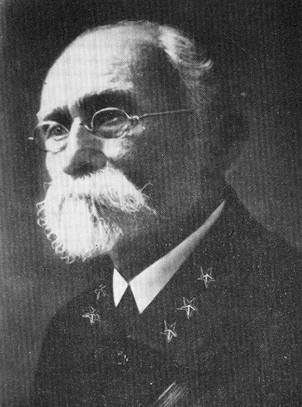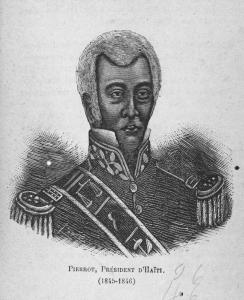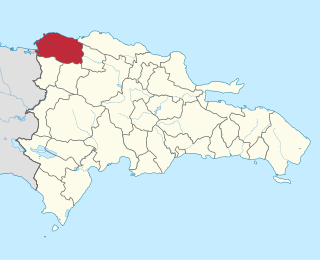
Máximo Gómez y Báez was a Cuban-Dominican Generalissimo in Cuba's War of Independence (1895–1898). He was known for his controversial scorched-earth policy, which entailed dynamiting passenger trains and torching the Spanish loyalists' property and sugar plantations—including many owned by Americans. He greatly increased the efficacy of the attacks by torturing and killing not only Spanish soldiers, but also Spanish sympathizers and especially Cubans loyal to Spain. By the time the Spanish–American War broke out in April 1898, the rebellion was virtually defeated in most of Western Cuba, with only a few operating pockets in the center and the east. He refused to join forces with the Spanish in fighting off the United States, and he retired to the Quinta de los Molinos, a luxury villa outside of Havana after the war's end formerly used by captains generals as summer residence.

The Dominican War of Independence was a war of independence that began when the Dominican Republic declared independence from the Republic of Haiti on February 27, 1844 and ended on January 24, 1856. Before the war, the island of Hispaniola had been united for 22 years when the newly independent nation, previously known as the Captaincy General of Santo Domingo, was unified with the Republic of Haiti in 1822. The criollo class within the country overthrew the Spanish crown in 1821 before unifying with Haiti a year later.

Prince Jean-Louis Michel Paul Pierrot, Baron of Haïti was a career officer general in the Haitian Army who also served as President of Haiti from 16 April 1845 to 1 March 1846.

Charles Rivière-Hérard also known as Charles Hérard aîné was an officer in the Haitian Army under Alexandre Pétion during his struggles against Henri Christophe. He was declared the president of Haiti on 4 April 1843. He was forced from office by revolutionaries on 3 May 1844.

The Dominican Restoration War or the Dominican War of Restoration was a guerrilla war between 1863 and 1865 in the Dominican Republic between nationalists and Spain, the latter of which had recolonized the country 17 years after its independence. The war resulted in the restoration of Dominican sovereignty, the withdrawal of Spanish forces, the separation of the Captaincy General of Santo Domingo from Spain, and the establishment of a second republic in the Dominican Republic.
The Battle of Santiago was the second major battle of the Dominican War of Independence and was fought on the 30 March 1844, at Santiago de los Caballeros, Santiago Province. Although outnumbered, Dominican troops, part of the Army of The North and led by General José María Imbert, defeated Haitian Army troops led by General Jean-Louis Pierrot.

The Battle of Las Carreras was a major battle during the years after the Dominican War of Independence and was fought on the 21–22 April 1849, nearby Baní, Peravia Province. A force of 800 Dominican troops, a portion of the Army of the South, led by General Pedro Santana, defeated an outnumbering force of 10,000 troops of the Haitian Army led by Faustin Soulouque.

The Battle of El Número was a battle during the years after the Dominican War of Independence and was fought on 17 April 1849, nearby Azua de Compostela, Azua Province. A force of 300 Dominican troops, a portion of the Army of the South, led by General Francisco Domínguez and General Antonio Duvergé defeated an outnumbering force of 10,000 troops of the Haitian Army led by General Jean Francois Jeannot.

The Battle of Beler was one of the major battles of the Dominican War of Independence and was fought on the 27 October 1845 at the Beler savanna, Monte Cristi Province. A force of Dominican troops, a portion of the Army of the North, led by General Francisco Antonio Salcedo, defeated a force of the Haitian Army led by General Jean-Louis Pierrot, while 3 Dominican schooners led by Admiral Juan Bautista Cambiaso, blockaded the port of Cap-Haïtien to prevent sea reinforcements of the near sited land battle.

The Battle of Estrelleta was a major battle of the Dominican War of Independence and was fought on September 17, 1845, at the site of Estrelleta, near Las Matas de Farfán, San Juan Province. A force of Dominican troops, a portion of the Army of the South, led by General Antonio Duvergé, defeated an outnumbering force of the Haitian Army led by General Jean-Louis Pierrot.

The Haitian occupation of Santo Domingo was the annexation and merger of then-independent Republic of Spanish Haiti into the Republic of Haiti, that lasted twenty-two years, from February 9, 1822, to February 27, 1844. The part of Hispaniola under Spanish administration was first ceded to France and merged with the French colony of Saint Domingue as a result of the Peace of Basel in 1795. However, with the outbreak of the Haitian Revolution the French lost the western part of the island, while remaining in control of the eastern part of the island until the Spanish recaptured Santo Domingo in 1809.

The Reintegration of Santo Domingo was a brief period of Spanish reintegration of the Dominican Republic. In 1861, Dominican general Pedro Santana suggested retaking control of the Dominican Republic to Queen Isabella II of Spain, after a period of 17 years of Dominican sovereignty. The newly independent Dominican Republic was recovering economically from the recently ended Dominican War of Independence (1844–1856), when the Dominican Republic had won its independence against Haiti. The Spanish Crown and authorities, which scorned and rejected the peace treaties signed after the dismantling of some of its colonies in the Spanish West Indies some 50 years prior, welcomed his proposal and set to reestablish the Capitancy.

Ulises Hilarión Heureaux Leibert nicknamed Lilís, was president of the Dominican Republic from September 1, 1882 to September 1, 1884, from January 6, 1887 to February 27, 1889 and again from April 30, 1889 maintaining power between his terms until his assassination by Ramón Cáceres.

Pablo Alí was a chief military commander of Haitian origin, who was in charge of the so-called Battalion 31 or Batallon de Morenos, freed slaves which joined the ranks of the Dominican army. Alí directed the battalion to participate in the Italian rebellion of 1810, during the government of Juan Sánchez Ramírez. He was said to have been "most prominent, achieving great military distinction in Santo Domingo".

Dominican Republic–Haiti relations are the diplomatic relations between the nations of Dominican Republic and Haiti. Relations have long been hostile due to substantial ethnic and cultural differences, historic conflicts, territorial disputes, and sharing the island of Hispaniola, part of the Greater Antilles archipelago in the Caribbean region. The living standards in the Dominican Republic are considerably higher than those in Haiti. The economy of the Dominican Republic is ten times larger than that of Haiti. The migration of impoverished Haitians and historical differences have contributed to long-standing conflicts.
The Massif du Nord is the longest mountain range of Haiti.

The Battle of Santomé was a major battle during the years after the Dominican War of Independence and was fought on 22 December 1855, in the province of San Juan. A detachment of Dominican troops forming part of the Army of the South, led by General José María Cabral, defeated an outnumbering force of the Haitian Army led by Antoine Pierrot. Almost 700 Haitian soldiers perished in the battle, and the rest, many of them wounded, were forced to retreat, being pushed back as far as the Fortress of Cachimán and subsequently beyond the border. The Haitians met defeat on the same day at the Battle of Cambronal.
The Battle of Fort Cachimán took place during the Dominican War of Independence on 6 December 1844 at the border close to Elías Piña. A force of Dominican troops, a portion of the Army of the South, led by General Antonio Duvergé, defeated an outnumbering force of the Haitian Army and captured the Haitian fort.

The Beheadings of Moca was a massacre that took place in Santo Domingo in April 1805 when the invading Haitian army attacked civilians as ordered by Jean-Jacques Dessalines and Henri Christophe, during their retreat to Haiti after the failed attempt to end French rule in Santo Domingo. The event was narrated by survivor Gaspar Arredondo y Pichardo in his book Memoria de mi salida de la isla de Santo Domingo el 28 de abril de 1805 , which was written nearly 40 years after the massacre is said to have taken place. The broader invasion was part of a series of Haitian invasions into Santo Domingo, and occurred after the return from the Siege of Santo Domingo (1805). Haitian historian Jean Price-Mars wrote that the troops killed the inhabitants of the targeted settlements irrespective of race.

The Battle of La Canela was a skirmish and one of the last battles of the Dominican Restoration War. This battle was fought on December 4, 1864, the forces of the Dominican Liberation Army commanded by Major General José María Cabral ambushed the Spanish royal army under the command of Colonel Herrera.

















